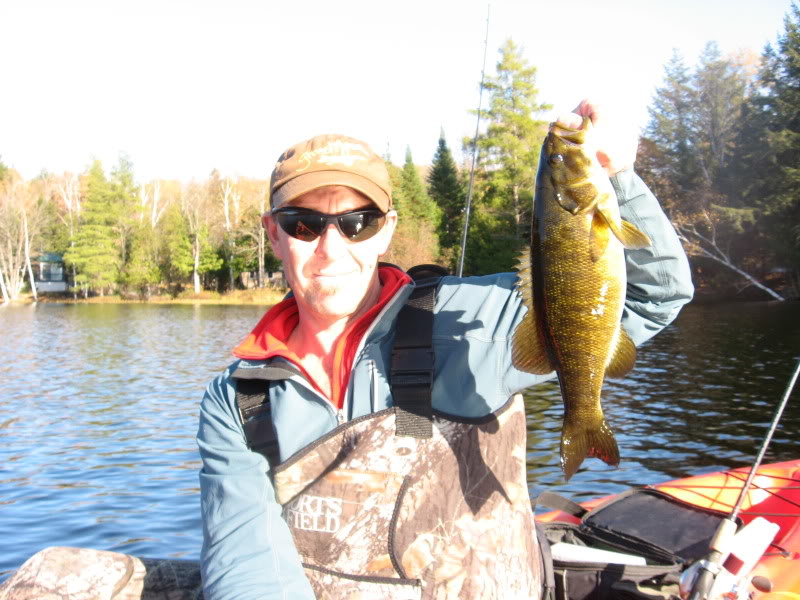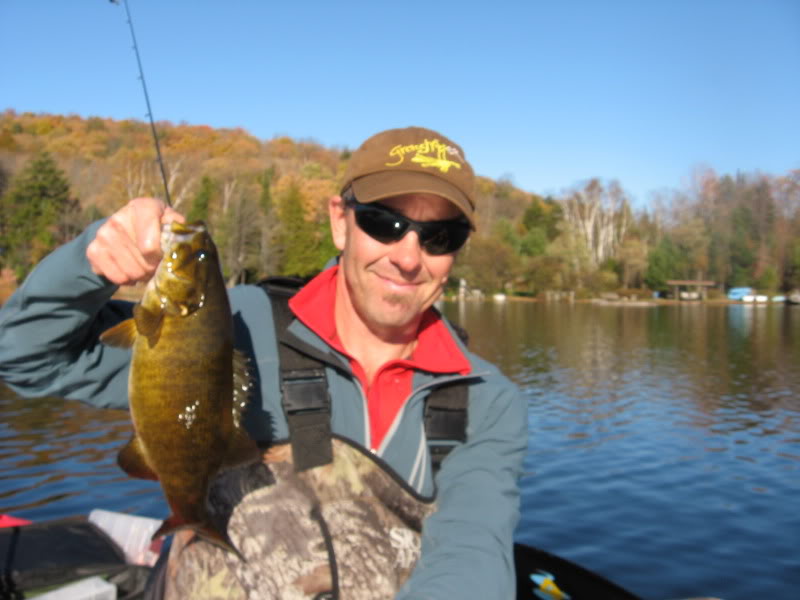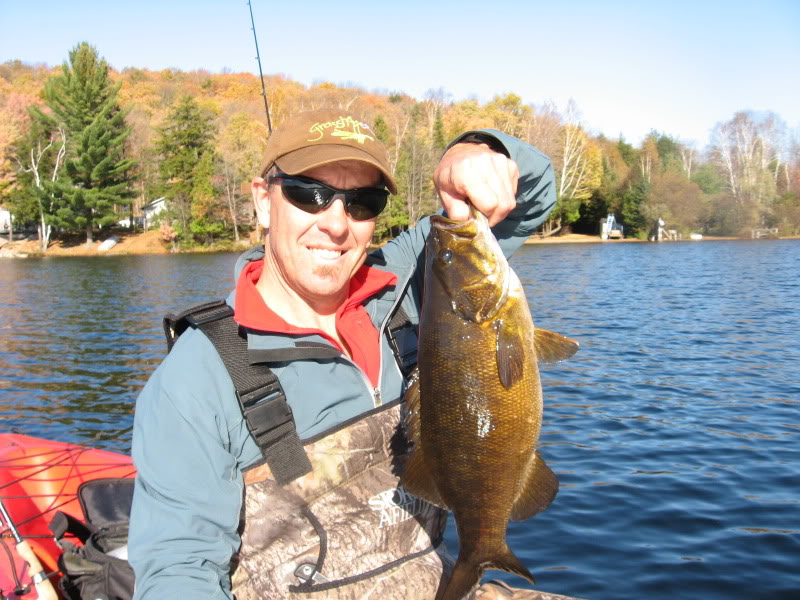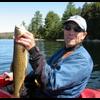-
Posts
1,047 -
Joined
-
Last visited
-
Days Won
1
Content Type
Events
Profiles
Forums
Store
Posts posted by singingdog
-
-
Yeah? Nice!
Where'd ya go?
Local lakes in Haliburton. If I were shorefishing I would be looking for current.
-
Good pike fishing and some muskie in Elephant also. I would stay out of the bush if the Moose guys are still banging away.
Ditto that. There are pickups parked everywhere....and lots of citiots out for their yearly dose of Daniel Boone.

-
I fish a fair amount of splake this time of year. I am heading to my favorite splake lake on Sunday.
I fish them like I would specks: if they are shallow and active I throw spoons, bucktails, small countdown raps, and small swimbaits to catch the lunkers. If they go deep, jigging spoons, jigs and lots of luck. I generally find them cruising the shallows this time of year, hitting pretty aggressivly for awhile and then turning off suddenly.
-
The smallies are definitely still biting...not super aggressive, but lots of big ones to be caught if you have the patience. There is some good rainbow fishing in that area as well.
Yes, there are lots of moose hunters out right now: leave your antler-hat at home!
-
I fished most of the day in the rain yesterday. It didn't seem to affect the bass bite.
-
You do need to consult a lawyer. I am not one, but teach a class on risk and legal liability in the tourism industry. Here's what I know.
Whether or not you are liable has to do with your "duty of care" to any users of your land. That duty of care is determined by your relationship to them. If you invite them, intentionally or unintentionally, you have a higher duty of care than if they use your land uninvited.
"If someone docks boat or fishes from a rocky shoreline on a private property, falls out, cracks their head open on the rock or drowns from falling off the cliff, who's liable?"
In this case, they are using your land uninvited and you therefore have a fairly low responsibilty to protect them from inherent risks. As long as you have not intentionally created dangerous conditions that then lead to injury or death, you have a very low chance of liability.
Putting No Trespassing signs may help keep people off your land, but will probably not reduce your liability. There are numerous cases of people being injure while trespassing and the fact that they are trespassing has been no defense against liability.
In additon to checking with your lawyer, you need to check with your insurance company. They will tell you what you need to do so that they will insure you if you are found to be liable.
The other questions you ask are outside of civil law, and are easily answered by a lawyer and a visit to the tax assessment office.
-
Like I said, start measuring the water temp. It's not very important during the summer bass season, but in the spring and fall it can save you ton of time trying to figure out the bite. Bass behaviour changes dramatically when the water temp drops below 55F. For me, that is often the transition between the "fall bite", when bass are active, aggressive and feed as though their lives depended on it, and the cold water bite, when they are slower, less aggressive and much more difficult to catch.
If the jerkbait isn't producing, try a tube or a senko fished real slow.
-
You may want to downsize the jerkbaits you are using. Nothing wrong with starting off big and fast, but slow and small is often the best bet when the water starts to cool. A size 8 Xrap is a good size this time of year. Don't be afraid to let the jerkbait sit for a loooooong time between twitches
Get yourself a thermometer and start keeping track of the water temps that you are fishing. A good log book is worth a tackle-box full of lures.
-
Got out yesterday on a lake that I have been trying to figure out for awhile. All I can say is "thank goodness for sonar!" It took about 1.5 hours to find them, but when I did, they were hitting. They were suspended in open water, just off a steep drop-off that went form 10-15' deep fairly quickly. Heavy football jigs, deep jerkbaits, slowrolled spinnerbaits, and tailspins all failed to produce fish, but a wacky-jigged 4" senko started producing. The hits were very subtle, making me wonder how many fish I missed before I figured out the "feel". 52 degrees and about 15' of visibility.
I had about 7 fish in the next hour, then I had to leave.
These 2 were typical: scrappy 15-16" fish that pulled like they were twice this size.


This was the biggest - and my best smallie of the year: 20.5 and deep. Gotta love those colours!

-
Interesting. I would reccomend the Compre as a better value than both the St Croix and the Loomis: great blanks at a great price. At those weights I would go with a Med power 6'6" or 7' , fast action. I would go bigger than a 1000 as well. A 2500 will take up line much quicker on those fish that head up or toward you after they hit.
-
get a downrigger clip and several lead weights to add to it. You can attach the clip to your line anywhere form 3-10' in front of the lure and add the amount of lead you need to get it down (1/4 oz would probably do it in this situation). The advantage to this system is in landing fish. When you have a fish on , reel in until you ge to the downrigger clip, unclip it from the line, and fight the fish with nothing on the line. This is the system I use for lakers, fishing as deep as 60' with 6lb test line.
-
The studies of mortality rates in deep caught bass and eyes seem to be fairly conclusive. If you are eating them, then go for it. If CnR is your goal, then deep fishing is not a great way to protect the resource.
-
Good line for me. I have the 4 lb, high vis spooled on my favourite trout fishing combo and like it alot. It seems to have good knot strength, good castability, and good abrasion resistance...what's not to like?
-
I have one and it has been good for me for the past 2 seasons: easy to adjust, pretty good casting distance once you get it dialed in. $100 doesn't seem like that good of a deal for one. There are tons of reels on sale right now.
I have fished the Accurist side-by-side with the Rick Clunn BC from BPS (on sale for $79 right now) and would buy the Rick Clunn before buying another Accurist. It is just as nice a reel, and seems to be holding up better.
-
Good points.
How could we get more people who use resources like you do more involved in the MNR?
I don't follow....why would someone want to get involved with a government ministry? Is there even a role for a private citizen?
I assume you mean "get involved protecting the resources they use?"
Lots of non-consumptive users are already very involved in organisations like:
-local Land Trusts: these are often protecting areas of significant natural interest and habitat that MNR has passed over, or are under the radar.
-"Friends" organisations of various parks and natural areas: nearly every large provincial park has a friends organisation that does everything from fund-raising to scientific monitoring
-local, provincial, national and international environmental organisations: yes, I would include Ducks Unlimited here, but other well-known environmental organisations
-citizen-science projects that contribute HUGE amounts of information to conservation efforts
-hiking, biking, paddling and naturalists organisations that do a large amout of direct-effort projects (trail maintenance, clean-up, monitoring, habitat restoration....)
These folks are not "antis". In fact, many of them are both hunters/fishers as well as pursuing other uses of the resource. If you really want to know the scope of stewardship projects that are being activly supported - with $ and time - by non-consumptive users, I can send you a list.
-
Hikers, naturalists, etc all enjoy what anglers and hunters pay to keep protected.
I like the user pay system, myself. But not all users are paying.
That's because hunters and fisherman are consuming something from the resource. Not paying? What do you call entrance fees to parks? Permit fees for canoe trails areas? I pay every time I go into Algonquin Park, whether I am fishing or not.
I pay a license fee for fishing because the fact that I am fishing creates the need for more enforcement and more protection. Hikers, naturalists, recreational canoeists and other non-consumptive users are not taking anything from the resource, nor do their actions require near as much enforcement infrastructure.
Bird-watching license? I would gladly pay it if they would stock good birds in my favourite areas, pay COs to penalise folks that are harming the watchable birds, manage habitat specifically for those species, and do loads of research on the health of watchable bird populations.
-
A spinnerbait is one of the most versatile bass lures out there. You can search with it, fish heavy cover with it, fish it fast, fish it slow....just don't get caught into thinking that it is a chuck-and-reel lure. Too many folks limit their sbait fishing to shallow, fast presentations and miss out on most of it's potential.
If I were going to own just one, it would be a white, 1/2 oz, double willow blade....but owning just one is not an option.
-
Downrigger clip with a 1/2 oz wt attached will get you down that deep. Clip it directly to your line about 20' above your lure. When you land a fish, take the clip off when it gets to the boat...land the fish with nothing between you and it.
-
Keep in mind that when Trigging, the bigger hook you use, the less wiggle you will get on the fall. Most of the time I use an Owner 1/0 Wide gap. It's short, but with a really wide gap that still gets good hookups. I will only go to a 3/0 or bigger if I feel the fish are not taking the whole bait into their mouth.
-
If you are ever up Haliburton way, drop me a line. I will steer you towards some excellent shore fishing spots.
-
Nice smallies! There are some real pigs there. There is something more than a new boat going on there....lots of folks have boats and don't land even one smallie like those. Nice!!
-
Thanks guys! I measured her with my forearm (Tip of my fingers to elbow). She was a bit longer which would make her about 20", not too sure about the girth though.
Sounds like good info to know for next time! How would I calculate weight based on length and girth?
There are a few calculators on the net. Here is the one I use: http://www.bassresource.com/bassfishing/fishcalculator.html
I carry a sewing measuring tape and do a quick length and girth measure....it's as fast as weighing the fish.
-
Nice fish!! Did you measure it at all? It's got good girth, so it could go 6 if it is 20-21". If you don't have a scale in the boat, a flexible tape will give you length and girth, which is a pretty accurate way to get weight.
-
I've tried several different models and have always returned to the lowly scum frog. Last weekend on Scugog I went 2-8 on a spro type with the weighted back end. I don't like this type of set up as I feel the button weight gets in the way of the body collapsing on hooks sets.
Yep...the weight keeps the frog from collapsing around the hooks. If I fish a Spro I smash the weight down with some pliers. Before I fish it I also "work" the body with my hands to soften it up.



Shield-lake dropshot
in General Discussion
Posted
I have been focusing more on drop-shot for big, finicky smallmouth. I am wondering what other folks that might be fishing shield-lakes are using for drop-shot baits. I have been using 4" senkos and small trick worms with some success. Anything else I should try?